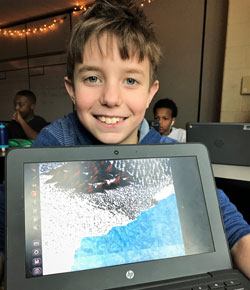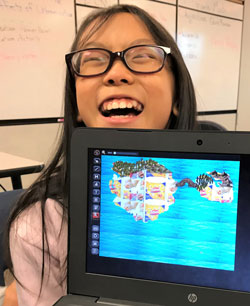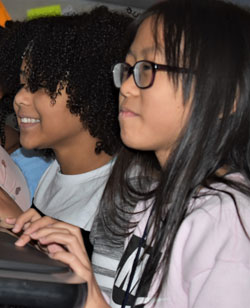A sixth-grade social studies class at Kelloggsville Middle School is making good use of a popular piece of map-making software.

The wrinkle? It’s not educational software. It’s called Inkarnate, and it has legendary status among Dungeons & Dragons players who use it to create the intricate and detailed maps the game demands.
First-year Kelloggsville teacher Bryce Pulley is one such D&D aficionado. He said making the software a pedagogical tool to help his students learn about islands and archipelagos and peninsulas and more made perfect sense.
“I always try to find ways to make class more enjoyable for not only the kids but also myself,” he said. “A common criticism by students of social studies and geography is that it is boring. As an avid Dungeons & Dragons player for the last nearly 10 years, I’ve been making maps for my own games, so it was a perfect fit to implement a map-making software I was familiar with into my classroom.”

Rafting Off Pizza Roll Island
During a recent class period, two of his students – Lisa Lin and Kira Sherrill – were working on their monthly map challenge, and smiling and chatting about what was on their screens.
Lisa was making what she called “pizza roll island.”
“I screenshotted this picture,” she said, “and now I’m playing around with it in Paint. It’s for the creative map contest, so, like, yeah. It’s different; it’s fun.”
The two then started talking about eating the island before a visitor noted that eventually they’d eat themselves out of a place to live.
“That’s when you raft off the island on the last pizza roll and eat it when you get to safety,” answered a nearby student with a matter-of-fact attitude that made it clear the visitor hadn’t thought nearly enough about living on a pizza roll island.
Across the room, Weston Haveman was working on a map called “Santa’s secret workshop” and talking animatedly about what he had included in the world and why.
“I put a whole bunch of mountains here,” he said, jabbing at his screen, “and a big fort and a big ice thing down here. It’s very detailed, and I still have to add all these dead trees yet. Yeah, it’s a lot of fun.”

Learning Behind the Scenes
Pulley likes that his students are having fun, but he said they’re also learning a lot more than they probably even realize as they use the software to bring their imaginations to life.
“When they’re doing the monthly map challenges, it’s nice when the learning is happening behind the scenes while they’re having fun,” he said. “When they’re actively creating their fantasy world but having to meet the requirements such as X amount of mountains, Y amount of islands, an archipelago, etcetera, I’ve found that the information sticks in their minds a lot easier than just looking at the same old world map.”
Pulley said he also likes that the software helps his students tap into some deeper and not-as-noticed skills they might not even be aware they are developing, like creativity, critical thinking, decision making, graphic design and even work ethic.
In the words of a quiet sixth grader named Cody Liang, who someday would like to be a computer engineer: “I really like thinking about my world and then getting on the computer and deciding how to make it, creating something new.”
CONNECT















